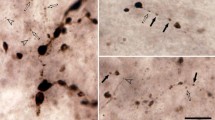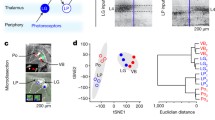Abstract
PERIPHERAL sensory deprivation induces reorganization within the somatosensory cortex of adult animals1-6. Although most studies have focused on the somatosensory cortex1–6, changes at subcortical levels (for example the thalamus) could also play a fundamental role in sensory plasticity7–11. To investigate this, we made chronic simultaneous recordings of large numbers of single neurons across the ventral posterior medial thalamus (VPM) in adult rats. This allowed a continuous and quantitative evaluation of the receptive fields of the same sample of single VPM neurons per animal, before and after sensory deprivation. Local anaesthesia in the face induced an immediate and reversible reorganization of a large portion of the VPM map. This differentially affected the short latency (4–6 ms) responses (SLRs) and long latency (15–25 ms) responses (LLRs) of single VPM neurons. The SLRs and LLRs normally define spatiotemporally complex receptive fields in the VPM12. Here we report that 73% of single neurons whose original receptive fields included the anaesthetized zone showed immediate unmasking of SLRs in response to stimulation of adjacent cutaneous regions, and/or loss of SLRs with preservation or enhancement of LLRs in response to stimulation of regions just surrounding the anaesthetized zone. This thalamic reorganization demonstrates that peripheral sensory deprivation may induce immediate plastic changes at multiple levels of the somatosensory system. Further, its spatiotemporally complex character suggests a disruption of the normal dynamic equilibrium between multiple ascending and descending influences on the VPM.
Similar content being viewed by others
References
Merzenick, M. M. et al. Neuroscience 8, 33–55 (1983).
Merzenick, M. M. et al. Neuroscience 10, 639–665 (1983).
Kaas, J. H. A. Rev. Neurosci. 14, 137–167 (1991).
Calford, M. B. & Tweedale, R. Nature 332, 446–448 (1988).
Calford, M. B. & Tweedale, R. J. Neurophysiol. 65, 178–187 (1991).
Calford, M. B. & Tweedale, R. Somatic Mot. Res. 8, 249–260 (1991).
Wall, P. D. & Egger, M. D. Nature 232, 542–545 (1971).
Nicolelis, M. A. L., Chapin, J. K. & Lin, R. C. S. Brain Res. 561, 344–349 (1991).
Garragthy, P. E. & Kaas, J. H. Neuroreport 2, 747–750 (1992).
Pons, T. P. et al. Science 252, 1857–1860 (1991).
Rausell, E., Cusick, C. G., Taub, E. & Jones, E. G. Proc. natn. Acad. Sci. U.S.A. 889, 2571–2575 (1992).
Nicolelis, M. A. L., Lin, R. S. C., Woodward, D. & Chapin, J. K. Proc. natn. Acad. Sci. U.S.A. (in the press).
Waite, P. M. E. J. Physiol., Lond. 228, 541–561 (1973).
Nakahama, H., Nishioka, S. & Otsuka, T. Prog. Brain Res. 21A, 180–196 (1966).
Rhoades, R. W., Belford, G. R. & Killackey, H. P. J. Neurophysiol. 57, 1577–1600 (1987).
Peschanski, M., Mantyh, P. W. & Besson, J. M. Brain Res. 278, 240–244 (1983).
Chmielowska, J., Carvel, G. E. & Simon, D. J. J. Comp. Neurol. 285, 325–338 (1988).
Author information
Authors and Affiliations
Rights and permissions
About this article
Cite this article
Nicolelis, M., Lin, R., Woodward, D. et al. Induction of immediate spatiotemporal changes in thalamic networks by peripheral block of ascending cutaneous information. Nature 361, 533–536 (1993). https://doi.org/10.1038/361533a0
Received:
Accepted:
Issue Date:
DOI: https://doi.org/10.1038/361533a0
- Springer Nature Limited
This article is cited by
-
Long-Term Training with a Brain-Machine Interface-Based Gait Protocol Induces Partial Neurological Recovery in Paraplegic Patients
Scientific Reports (2016)
-
Increased cortical responses to forepaw stimuli immediately after peripheral deafferentation of hindpaw inputs
Scientific Reports (2014)
-
Chronic, wireless recordings of large-scale brain activity in freely moving rhesus monkeys
Nature Methods (2014)
-
Existe-t-il une matrice de la douleur neuropathique ?
Douleur et Analgésie (2014)
-
Cutaneous sensory feedback plays a critical role in agonist–antagonist co-activation
Experimental Brain Research (2013)





